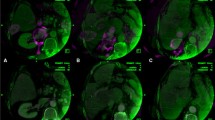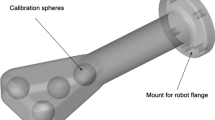Abstract
Purpose
Images from computed tomography (CT), combined with navigation systems, improve the outcomes of local thermal therapies that are dependent on accurate probe placement. Although the usage of CT is desired, its availability for time-consuming radiological interventions is limited. Alternatively, three-dimensional images from C-arm cone-beam CT (CBCT) can be used. The goal of this study was to evaluate the accuracy of navigated CBCT-guided needle punctures, controlled with CT scans.
Methods
Five series of five navigated punctures were performed on a nonrigid phantom using a liver specific navigation system and CBCT volumetric dataset for planning and navigation. To mimic targets, five titanium screws were fixed to the phantom. Target positioning accuracy (TPECBCT) was computed from control CT scans and divided into lateral and longitudinal components. Additionally, CBCT-CT guidance accuracy was deducted by performing CBCT-to-CT image coregistration and measuring TPECBCT-CT from fused datasets. Image coregistration was evaluated using fiducial registration error (FRECBCT-CT) and target registration error (TRECBCT-CT).
Results
Positioning accuracies in lateral directions pertaining to CBCT (TPECBCT = 2.1 ± 1.0 mm) were found to be better to those achieved from previous study using CT (TPECT = 2.3 ± 1.3 mm). Image coregistration error was 0.3 ± 0.1 mm, resulting in an average TRE of 2.1 ± 0.7 mm (N = 5 targets) and average Euclidean TPECBCT-CT of 3.1 ± 1.3 mm.
Conclusions
Stereotactic needle punctures might be planned and performed on volumetric CBCT images and controlled with multidetector CT with positioning accuracy higher or similar to those performed using CT scanners.






Similar content being viewed by others
References
McCarley JR, Soulen MC (2010) Percutaneous ablation of hepatic tumors. Sem Interv Radiol 27:255–260
Racadio JM, Babic D, Homan R, Rampton JW, Patel MN, Racadio JM, Johnson ND (2007) Live 3D guidance in the interventional radiology suite. AJR Am J Roentgenol 189:W357–W364
Wood BJ, Kruecker J, Locklin J, Levy E, Xu S, Solbiati L, Amalou H, Venkatesan A (2011) Navigation systems for ablation. J Vasc Interv Radiol 21:1–19
Minami Y, Kudo M, Kawasaki T, Chung H, Ogawa C, Shiozaki H (2004) Percutaneous radiofrequency ablation guided by contrast-enhanced harmonic sonography with artificial pleural effusion for hepatocellular carcinoma in the hepatic dome. AJR Am J Roentgenol 182:1224–1226
Dill-Macky MJ, Asch M, Burns P, Wilson S (2006) Radiofrequency ablation of hepatocellular carcinoma: predicting success using contrast-enhanced sonography. AJR Am J Roentgenol 186(5 Suppl):S287–S295
van den Bosch M, Daniel B, Rieke V, Butts-Pauly K, Kermit E, Jeffrey S (2008) MRI-guided radiofrequency ablation of breast cancer: preliminary clinical experience. J Magn Reson Imaging 27:204–208
Livraghi T, Solbiati L, Meloni F, Ierace T, Goldberg SN, Gazelle GS (2003) Percutaneous radiofrequency ablation of liver metastases in potential candidates for resection: the “test-of-time approach”. Cancer 97:3027–3035
Dromain C, De Baere T, Elias D, Kuoch V, Ducreux M, Boige V, Petrow P, Roche A, Robert S (2002) Hepatic tumors treated with ablation: CT and MR imaging. Radiology 223:255–262
Kim SK, Lim HK, Kim YH, Lee WJ, Lee SJ, Kim SH, Lim JH, Kim SA (2003) Hepatocellular carcinoma treated with radio-frequency ablation: spectrum of imaging findings. Radiographics 23:107–121
Oliveira-Santos T, Klaeser B, Weitzel T, Krause T, Nolte LP, Peterhans M, Weber S (2011) A navigation system for percutaneous needle interventions based on PET/CT images: design, workflow and error analysis of soft tissue and bone punctures. Comput Aided Surg 16:203–219
Meier-Meitinger M, Nagel M, Kalender W, Bautz WA, Baum U (2008) Computer-assisted navigation system for interventional CT-guided procedures: results of phantom and clinical studies. RöFo 180:310–317
Orth RC, Wallace MJ, Kuo MD (2008) C-arm cone-beam CT: general principles and technical considerations for use in interventional radiology. J Vasc Interv Radiol 19:814–820
Braak SJ, van Strijen MJL, van Leersum M, van Es HW, van Heesewijk JPM (2010) Real-time 3D fluoroscopy guidance during needle interventions: technique, accuracy, and feasibility. AJR Am J Roentgenol 194:445–451
Leschka SC, Babic D, El Shikh S, Wossmann C, Schumacher M, Taschner C (2012) C-arm cone beam computed tomography needle path overlay for image-guided procedures of the spine and pelvis. Neuroradiology 54:215–223
Wallace MJ, Kuo MD, Glaiberman C, Binkert CA, Orth RC, Soulez G (2008) Three-dimensional C-arm cone-beam CT: applications in the interventional suite. J Vasc Interv Radiol 19:799–813
Wallach D, Toporek G, Weber S, Bale R, Widmann G (2013) Comparison of free-hand navigated and aiming device navigated targeting of liver lesions. Int J Med Robot Comput Assist Surg (in press)
Peterhans M, vom Berg A, Dagon B, Inderbitzin D, Baur C, Candinas D, Weber S (2011) A navigation system for open liver surgery: design, workflow and first clinical applications. Int J Med Robot Comput Assist Surg 7(1):7–16
Tschannen M, Toporek G, Wallach D, Peterhans M, Weber S (2012) Single-marker localization for automatic patient registration in interventional radiology. In: CURAC 2012, Düsseldorf
Oliveira-Santos T, Peterhans M, Hofmann S, Weber S (2011) Passive single marker tracking for organ motion and deformation detection in open liver surgery. In: Proceedings of the second international conference on information processing in computer-assisted interventions, pp 156–167
Widmann G, Schullian P, Ortler M, Bale R (2012) Frameless stereotactic targeting devices: technical features, targeting errors and clinical results. Int J Med Robot Comput Assist Surg 8:1–16
Widmann G, Stoffner R, Sieb M, Bale R (2009) Target registration and target positioning errors in computer-assisted neurosurgery: proposal for a standardized reporting of error assessment. Int J Med Robot Comput Assist Surg 5:355–365
Möhlenbruch M, Nelles M, Thomas D, Willinek W, Gerstner A, Schild HH, Wilhelm K (2010) Cone-beam computed tomography-guided percutaneous radiologic gastrostomy. Cardiovasc Interv Radiol 33:315–320
Maier-Hein L, Pianka F, Seitel A, Müller SA, Tekbas A, Seitel M, Wolf I, Schmied BM, Meinzer H (2007) Precision targeting of liver lesions with a needle-based soft tissue navigation system. Med Image Comput Comput Assist Interv 10(Pt 2):42–49
Maier-Hein L, Tekbas A, Seitel A, Pianka F, Müller SA, Satzl S, Schawo S, Radeleff B, Tetzlaff R, Franz AM, Müller-Stich BP, Wolf I, Kauczor HU, Schmied BM, Meinzer HP (2008) In vivo accuracy assessment of a needle-based navigation system for CT-guided radiofrequency ablation of the liver. Med Phys 35:5385–5396
Morimoto M, Numata K, Kondo M, Nozaki A, Hamaguchi S, Takebayashi S, Tanaka K (2010) C-arm cone beam CT for hepatic tumor ablation under real-time 3D imaging. AJR Am J Roentgenol 194:W452–W454
Hirota S, Nakao N, Yamamoto S, Kobayashi K, Maeda H, Ishikura R, Miura K, Sakamoto K, Ueda K, Baba R (2006) Cone-beam CT with flat-panel-detector digital angiography system: early experience in abdominal interventional procedures. Cardiovasc Interv Radiol 29:1034–1038
Fujioka C, Horiguchi J, Ishifuro M, Kakizawa H, Kiguchi M, Matsuura N, Hieda M, Tachikake T, Alam F, Furukawa T, Ito K (2006) A feasibility study: evaluation of radiofrequency ablation therapy to hepatocellular carcinoma using image registration of preoperative and postoperative CT. Acad Radiol 13:986–994
Lawson JD, Schreibmann E, Jani AB, Fox T (2007) Quantitative evaluation of a cone-beam computed tomography-planning computed tomography deformable image registration method for adaptive radiation therapy. J Appl Clin Med Phys 8:2432
Paquin D, Levy D, Xing L (2009) Multiscale registration of planning CT and daily cone beam CT images for adaptive radiation therapy. Med Phys 36:4
Hou J, Guerrero M, Chen W, D’Souza WD (2011) Deformable planning CT to cone-beam CT image registration in head-and-neck cancer. Med Phys 38:2088–2094
Kral F, Url C, Widmann G, Riechelmann H, Freysinger W (2011) The learning curve of registration in navigated skull base surgery. Laryngorhinootologie 90:90–93
Widmann G, Schullian P, Haidu M, Wiedermann FJ, Bale R (2010) Respiratory motion control for stereotactic and robotic liver interventions. Int J Med Robot 6:343–349
Acknowledgments
Parts of the work presented in this manuscript are founded by the Eurostars-Eureka Programme under the project iVisc (E!6201). The authors thank CAScination AG, Bern, Switzerland, for providing hardware support, Dr. Matthias Peterhans and Sylvain Anderegg for valuable support during the development of the approach, and finally Kate A. Gavaghan and Tom Williamson for proofreading the paper.
Conflict of interest
Grzegorz Toporek, Dr. Daphné Wallach, Prof. Dr. Stefan Weber, and Dr. Gerlig Widmann declare no conflict of interest. Prof. Reto Bale is a coinventor of the stereotactic ATLAS aiming device (Medical Intelligence GmbH, Schwabmünchen, Germany) and a coshareholder in its financial returns.
Author information
Authors and Affiliations
Corresponding author
Rights and permissions
About this article
Cite this article
Toporek, G., Wallach, D., Weber, S. et al. Cone-beam Computed Tomography-guided Stereotactic Liver Punctures: A Phantom Study. Cardiovasc Intervent Radiol 36, 1629–1637 (2013). https://doi.org/10.1007/s00270-013-0635-x
Received:
Accepted:
Published:
Issue Date:
DOI: https://doi.org/10.1007/s00270-013-0635-x




